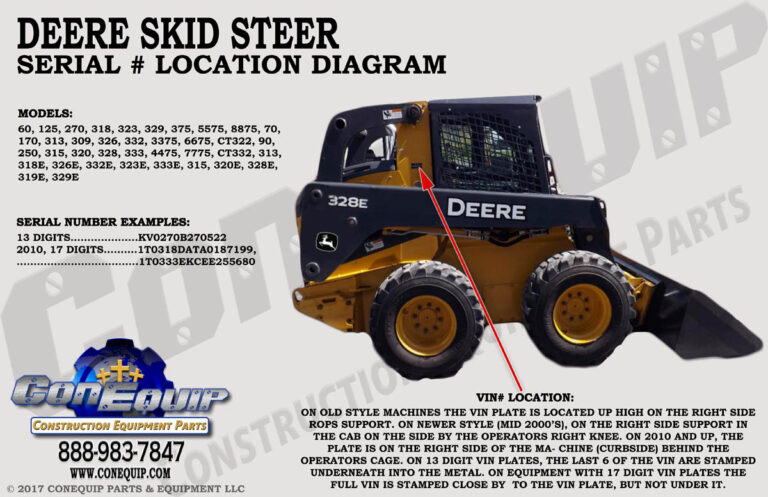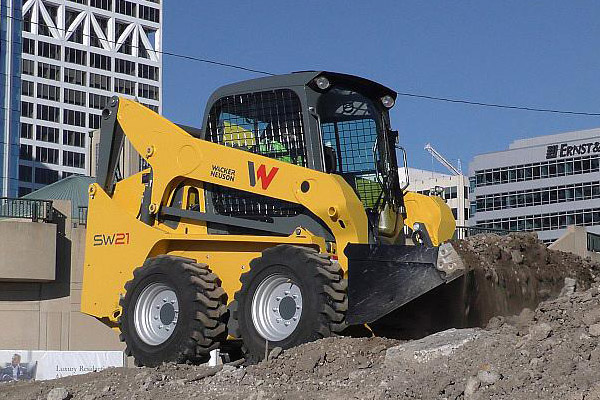What is the Maximum Speed of a Skid Steer? Unveiled
The maximum speed of a skid steer typically ranges from 6 to 12 mph, depending on the model. Some high-performance models can reach speeds up to 14 mph.
Skid steers are versatile machines used in construction, landscaping, and agriculture. Their compact size allows them to maneuver easily in tight spaces while providing powerful lifting capabilities. Operators rely on skid steers for tasks like digging, grading, and material handling.
The speed of a skid steer can significantly impact productivity on job sites. Understanding the maximum speed helps operators choose the right model for specific tasks. Whether you need a machine for heavy lifting or quick transport, knowing the speed is crucial for efficient operation. Explore various models to find the best fit for your needs.
The Essence Of Speed In Skid Steer Performance
Speed is vital in skid steer performance. It directly affects productivity and efficiency. Fast machines complete tasks quicker, saving time and money. Operators seek optimal speed for various applications, such as construction and landscaping.
Understanding maximum speed helps operators choose the right model. Speed impacts maneuverability, especially in tight spaces. A faster skid steer can navigate obstacles with ease. Yet, speed must balance with power and control.
Key Factors Influencing Skid Steer Velocity
Several factors affect the speed of a skid steer. These include:
- Engine Power: Higher horsepower boosts speed.
- Weight: Lighter machines often go faster.
- Traction: Tire quality impacts speed on different surfaces.
- Transmission Type: Hydrostatic transmissions enhance speed control.
The Role Of Horsepower And Torque
Horsepower and torque play key roles in skid steer speed.
| Term | Description |
|---|---|
| Horsepower | Measures engine power, affecting overall speed. |
| Torque | Indicates pulling power, crucial for heavy loads. |
High horsepower enables quick acceleration. Torque allows the machine to maintain speed under load. Operators must consider both for optimal performance.
For instance, a skid steer with 60 horsepower can reach speeds up to 10 mph. However, higher torque may be needed for tough jobs. This balance helps in achieving the best speed and efficiency.

Credit: rl-machinery.en.made-in-china.com
Breaking Down Skid Steer Specifications
Understanding skid steer specifications helps users select the right machine. Various factors impact performance. These include hydraulics, weight, and size.
Standard Vs. High-flow Hydraulics
Hydraulic systems determine the machine’s power and efficiency. Skid steers typically come with two types: standard and high-flow hydraulics.
- Standard Hydraulics:
- Suitable for basic attachments
- Flow rate around 10-20 gallons per minute
- High-Flow Hydraulics:
- Higher cost
- Supports advanced attachments
- Flow rate around 20-40 gallons per minute
Choose the hydraulic system based on your needs. High-flow systems enhance productivity with heavy attachments.
Weight And Size Considerations
Weight and size influence a skid steer’s speed and stability. Heavier machines provide better traction. Smaller models offer enhanced maneuverability.
| Model | Weight (lbs) | Length (in) | Width (in) | Max Speed (mph) |
|---|---|---|---|---|
| Model A | 3,000 | 110 | 68 | 7 |
| Model B | 4,500 | 120 | 72 | 6 |
| Model C | 2,500 | 102 | 65 | 8 |
Consider these specifications for your tasks. Heavier models provide stability. Lighter models are easier to transport.
Comparative Analysis: Skid Steer Models And Speeds
Understanding the maximum speed of various skid steer models helps buyers make informed choices. Different models cater to different needs. Some prioritize speed, while others focus on power. This analysis compares the top contenders in the market based on speed.
Top Contenders In The Skid Steer Market
Here are some of the leading skid steer models known for their speed:
- Bobcat S650 – Maximum speed: 7.4 mph
- John Deere 318G – Maximum speed: 6.5 mph
- CAT 262D – Maximum speed: 7.0 mph
- CASE SV340 – Maximum speed: 7.2 mph
- New Holland L230 – Maximum speed: 7.2 mph
How Brands Stack Up In Speed
| Brand | Model | Maximum Speed (mph) |
|---|---|---|
| Bobcat | S650 | 7.4 |
| John Deere | 318G | 6.5 |
| CAT | 262D | 7.0 |
| CASE | SV340 | 7.2 |
| New Holland | L230 | 7.2 |
These models vary in speed, but all deliver excellent performance. Choose according to your specific needs. Speed is just one factor to consider.
The Peak Performance: Unveiling Maximum Speeds
Skid steers are essential machines on job sites. Their speed matters for efficiency. Knowing the maximum speeds helps choose the right model. Let’s dive into the peak performance of skid steers and uncover their fastest capabilities.
Record-holding Skid Steer Models
Some skid steers stand out for their impressive speeds. Here are a few record-holding models:
| Model | Maximum Speed (mph) | Manufacturer |
|---|---|---|
| Bobcat S650 | 7.0 | Bobcat Company |
| Case 440N | 7.0 | Case Construction |
| CAT 262D | 7.2 | Caterpillar |
These models excel in speed and performance. Fast skid steers can boost productivity. Users can complete tasks quickly and efficiently.
What Limits A Skid Steer’s Top Speed?
Several factors impact a skid steer’s maximum speed. Understanding these limits is key for operators.
- Engine Power: More power equals higher speeds.
- Weight: Heavier machines have slower speeds.
- Tire Size: Larger tires can affect speed and traction.
- Terrain: Rough or uneven ground slows down performance.
- Safety Features: Speed limits enhance safety on the job site.
Each factor plays a role in the overall speed. Operators should consider these when selecting a skid steer.
Operational Efficiency Vs. Speed
Speed in a skid steer influences overall operational efficiency. High speeds can boost productivity but may risk safety. Finding the right balance is crucial for effective operations.
When Speed Matters In Skid Steer Tasks
Certain tasks require different speeds. Here are key scenarios:
- Site Clearing: Quick movement helps clear debris faster.
- Material Transport: Speed saves time when moving materials.
- Landscaping: Fast operations can enhance project timelines.
- Excavation: Speed aids in digging and moving soil efficiently.
| Task | Ideal Speed (mph) | Benefits |
|---|---|---|
| Site Clearing | 8-10 | Quick debris removal |
| Material Transport | 5-7 | Increased efficiency |
| Landscaping | 4-6 | Faster project completion |
| Excavation | 3-5 | Efficient digging |
Balancing Speed With Control And Safety
High speed can decrease control. Operators must prioritize safety. Here are some tips:
- Use proper training for operators.
- Adjust speeds based on terrain.
- Regularly inspect equipment.
- Maintain clear communication on-site.
Operators should also follow these safety practices:
- Wear safety gear consistently.
- Monitor surroundings for obstacles.
- Reduce speed in tight spaces.
- Follow manufacturer speed recommendations.
Balancing speed with control leads to safer, more efficient operations. Optimal performance in skid steers is achievable with proper strategies.

Credit: m.made-in-china.com
Technological Advances In Skid Steer Design
The design of skid steers has evolved rapidly. New technologies enhance performance and speed. These advances make skid steers more efficient and powerful.
Innovations Boosting Speed Capabilities
Several innovations have improved the speed of skid steers:
- Advanced Engine Technology: New engines offer better power-to-weight ratios.
- Hydraulic Systems: Enhanced hydraulics increase lifting speed and efficiency.
- Electronic Controls: Smart controls allow for faster response times.
The following table highlights some key innovations:
| Innovation | Benefit |
|---|---|
| Turbocharged Engines | Higher horsepower for faster speeds |
| Variable Speed Drive | Smooth acceleration and deceleration |
| Improved Tire Designs | Better traction leads to faster movement |
Future Trends In Skid Steer Development
Future trends will further enhance skid steer speed:
- Electric Models: Quieter and faster with fewer emissions.
- Autonomous Features: Self-driving capabilities for increased efficiency.
- Smart Sensors: Real-time data for better performance and safety.
These trends signal a shift in how skid steers operate. The future promises even more speed and efficiency.
The Impact Of Terrain On Skid Steer Speed
Skid steers are versatile machines. Their speed varies based on terrain. Understanding these effects helps operators maximize performance. Different ground conditions challenge the machine’s abilities.
Adapting To Different Ground Conditions
Various terrains affect skid steer speed. Here are key factors:
- Soft Soil: Slower speeds occur in mud or sand.
- Rough Terrain: Bumpy ground reduces stability and speed.
- Hard Surfaces: Asphalt or concrete allows for higher speeds.
- Inclines: Uphill and downhill slopes impact acceleration.
Operators must adjust driving techniques for different surfaces. Smooth driving improves efficiency and speed. Avoid rapid turns to maintain traction.
Tire And Track Options For Optimal Speed
Tires and tracks play a vital role in speed. Each option has unique benefits:
| Type | Speed | Best For |
|---|---|---|
| Pneumatic Tires | Faster on hard surfaces | Concrete, asphalt |
| Tracks | Stability, slower speeds | Mud, snow, rough terrain |
Choosing the right option enhances performance. Operators should consider job requirements when selecting tires or tracks. Proper maintenance also ensures optimal speed.
Best Practices For Maximizing Skid Steer Speed
Maximizing the speed of a skid steer requires attention to detail. Proper maintenance and operator training can significantly enhance performance. Here are some essential practices to follow.
Maintenance Tips For Peak Performance
Regular maintenance keeps your skid steer running at top speed. Follow these maintenance tips:
- Check Fluid Levels: Inspect hydraulic fluid and engine oil regularly.
- Inspect Tires: Ensure tires are properly inflated and in good condition.
- Clean Air Filters: Dirty filters reduce engine efficiency.
- Service the Engine: Follow the manufacturer’s service schedule.
Consider this table for a quick maintenance schedule:
| Maintenance Task | Frequency |
|---|---|
| Fluid Checks | Weekly |
| Tire Inspection | Monthly |
| Air Filter Cleaning | Every 50 hours |
| Engine Service | Every 250 hours |
Operator Training For Enhanced Efficiency
Skid steer speed also depends on operator skill. Effective training boosts efficiency. Consider these training tips:
- Understand Controls: Familiarize with all machine controls.
- Practice Maneuvering: Improve speed with practice in open areas.
- Use Proper Techniques: Train on smooth driving and swift turns.
- Stay Alert: Awareness of surroundings enhances safety and speed.
Investing time in training pays off. A skilled operator achieves better speed and efficiency.

Credit: www.everun.com
Frequently Asked Questions
What Is The Top Speed Of A Skid Steer?
The top speed of a skid steer typically ranges from 6 to 12 miles per hour. This speed varies based on the model and manufacturer. Higher-end models may achieve faster speeds, while compact models prioritize maneuverability over speed. Always check the specifications for precise details.
How Fast Can A Skid Steer Travel In Reverse?
A skid steer can travel in reverse at speeds similar to its forward speed, usually around 6 to 12 miles per hour. This allows operators to maneuver efficiently in tight spaces. The ability to reverse at similar speeds enhances productivity on job sites.
What Affects A Skid Steer’s Maximum Speed?
Several factors affect a skid steer’s maximum speed. These include engine power, weight, and tire size. Terrain type also plays a significant role, as rough or uneven surfaces can limit speed. Additionally, operator skill can impact how effectively the machine reaches its maximum speed.
Are All Skid Steers The Same Speed?
No, not all skid steers have the same speed. Different models are designed for various applications, affecting their top speeds. Compact models often prioritize maneuverability, while larger models may focus on speed and power. Always consult the manufacturer’s specifications for accurate speed information.
Conclusion
Understanding the maximum speed of a skid steer is crucial for effective operation. These machines typically reach speeds between 6 to 10 mph, depending on the model. Knowing this helps you choose the right skid steer for your project. Always consider speed alongside other factors like power and maneuverability for optimal performance.







